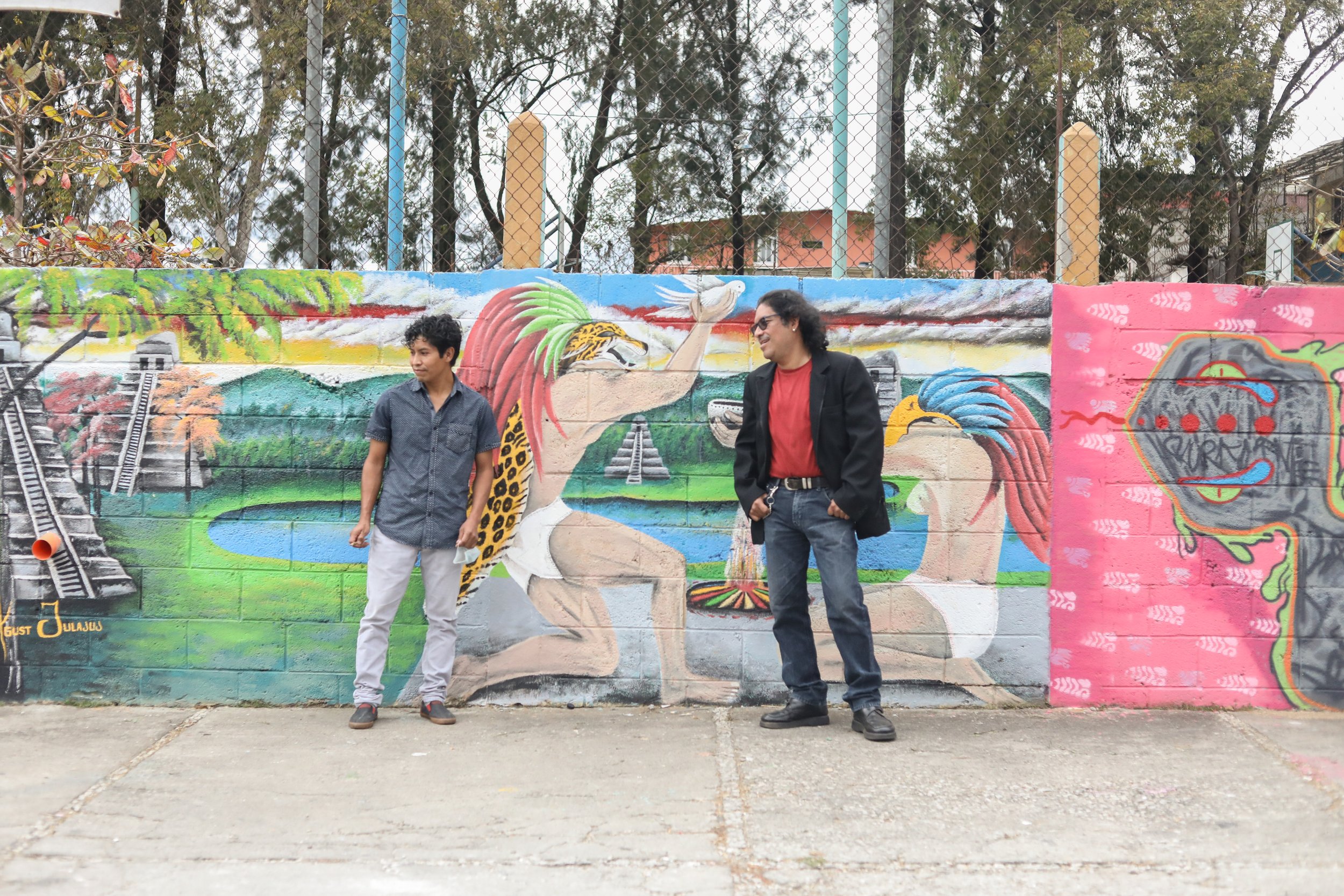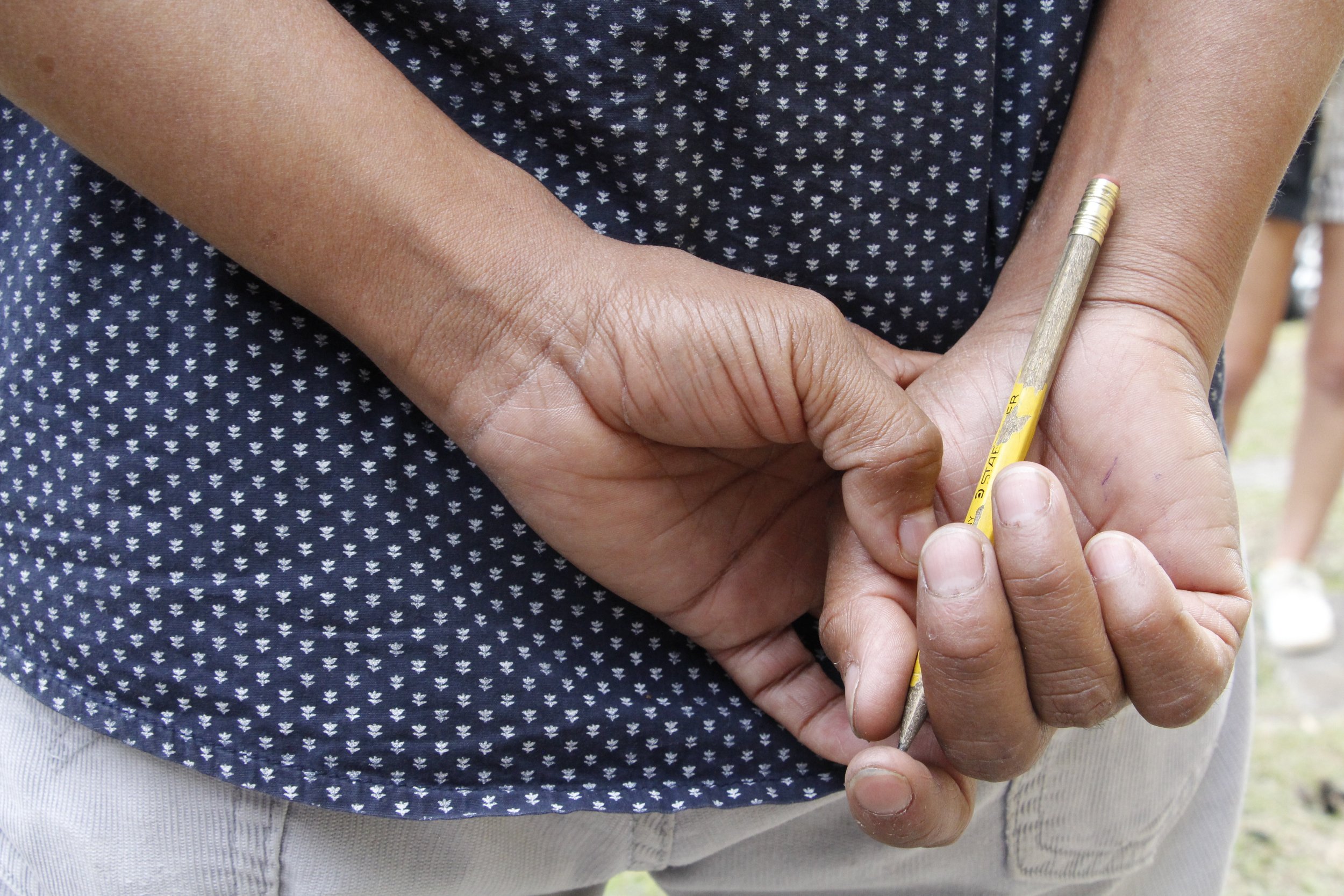Pillars of paint
Artist Agustín Julajuj seeks beauty while supporting his nieces and nephews out of the family business.
By Rachel Blood
One-year-old Andrea runs across the floor of her family’s Guatemala City tienda, tugging a pencil from the calloused hands of Agustín Julajuj. In front of a wall crammed with packs of cookies and refried beans, she grins as she twirls it in her hands the same way her uncle does, between her index finger and thumb, the pencil’s yellow paint chipped away from constant exposure to the skin of an artist. Julajuj always has a pencil with him, tucked behind his ear or poking out of his pocket or rolling in his palms, just in case he needs to capture beauty.
And Julajuj sees beauty everywhere: the coat of a jaguar, the water of Lake Atitlán and his bustling home of nieces and nephews.
A self-taught artist, Julajuj, 36, paints and works in the tienda – a type of small neighborhood convenience store common in Guatemala – to support his family in a place where artists have little to no support and resources. Whether participating in a muralist project that faced municipal resistance or giving art lessons out of his home, Julajuj finds ways to make.
He makes time for his family, time for the three nephews and two nieces living in the space that serves as store, home and studio.
He makes the best of being an artist surrounded by the chaos of Zone 7.
He makes art.
On the corner of two bustling Zone 7 Kaminaljuyú streets in Guatemala City – the capital with almost three million people – brick pillars painted with parrots, trees and blue skies mark the abode of Julajuj’s family, along with his studio and store. Past the painted pillars in a space partially exposed to the outdoors, green metal bars separate 25-packs of plastic forks, single packets of shampoo and paintbrushes for sale from the walls of Julajuj’s paintings. Hung in frames or brushed onto canvases that lean against the walls are glimpses of Julajuj’s life: Two nephews and a niece huddled together, posing for a portrait. A landscape of a Guatemala City street. A herd of heterochromatic white cats.
The chatter of seven children fills the space as two skinny cats, white and brown, dart between bars of the gate and disappear under the gap beneath Julajuj’s studio door. A pair of sparkly children’s shoes sit atop a pillar.
Julajuj paints and works at his family’s shop. Living with his mother, sister, two nieces and three nephews, Julajuj works to provide for his family while dreaming of a bachelor’s degree in art at Universidad de San Carlos de Guatemala. The program runs Monday through Friday, leaving Julajuj unable to attend. He needs to work, so he makes a living by balancing his time in the tienda with teaching art classes twice a week to two students: 15-year-old José Pablo Saravia and 60-year-old Irma Yolanda Rodríguez.
Following his brother’s death from a cerebral hemorrhage in 2008, Julajuj took over the care of his oldest niece, Sandra. After Sandra’s mother died of diabetes in 2017, Evelin and Julio moved in, too. With six-year-old nephew Ángel, three-year-old nephew Daniel and one-year-old niece Andrea, the kids learn art from Julajuj when they’re not in school, filling sketchbooks and canvases with lead and acrylics. Sandra has since moved out.
“Mi favorita,” Evelin says, flipping to a page of her sketchbook depicting a girl with a splash of color in the red flowers adorning her hair.
“I feel very happy and satisfied knowing that they can develop it better through me and in an easier way,” Julajuj said. “At least they have my support in whatever they need and what I did not have.”
After being born in a village near Lake Atitlán, Julajuj moved three hours east to Guatemala City at age 10 due to a lack of teachers in his home village. In school, classmates would flock to him for help with paintings and drawings after seeing Julajuj excel with acrílicos. At 16, he was gifted tempura paints, a type of fast-drying pigment mixed with glutinous materials such as egg yolk.
“I fell in love with color,” Julajuj said. “With those colors I was born again. Those colors are forever marked in me … I was not the same.”
Julajuj wants his nieces and nephews to have successful careers but also wants them to be able to express the creativity in their blood.
“Art runs through their veins,” Julajuj said. “[I want them] to not study a career only to have a profession, but also for them to study for life and use art to be inspired.”
Evelin wants to be a doctor, chef and painter. Julio wants to be an English-speaking mechanic and painter. Ángel wants to be a lawyer and painter.
To show his nieces and nephews the importance of continuing to seek beauty in life, Julajuj doesn’t stop with the paintings hanging on the walls of his shop. Outside his home, metal panels show two street dogs and a host of other pets Julajuj has had over the years. Down the street, Centro Espiritual Maya is filled with his brushstrokes of fauna, flora and the 20 sacred Mayan nahuales.
As Julajuj painted a nature-focused mural on the side of his Guatemala City home one day, freelance artist Angel Castellanos walked by and struck up a conversation. The two artists began a friendship fostering support and creativity, the exterior of Julajuj’s home inspiring Castellanos to expand the reach of street art to a communal space.
“[I did it because] it is a public space that belongs to all of us as neighbors,” Julajuj said. “What’s better than being able to show some of our art where we live?”
With Julajuj as one of his first recruits, Castellanos launched Proyecto Kaminaljuyú – an urban street art project – in July 2021. With the help of Julajuj, volunteer Michelle Mendoza and social media manager Celeste Ovando, more than 40 artists from throughout Central America flocked to Kaminaljuyú to spend two days filling the park with color. After four months of planning and two days of painting, 17 murals decorated the interior and exterior of the sports fields in Kaminaljuyú.
Julajuj’s mural was the last part of Proyecto Kaminaljuyú to be completed, as Julajuj had to touch up a few of the parts budding artists Evelin and Julio helped out with. The work depicts Mayan prince Kaibil Balam adorned in jaguar hides, kneeling and holding a white pigeon in the air. Julajuj spent a month planning the mural, studying the characters and visual elements to see what worked and what didn’t. Did he want to paint a sunset? How would the background come together?
On Kaibil Balam’s right is Princess Xinabajul, completing a Mayan fire ritual still performed today. Julajuj believes his mural is what the Mayan civilization of Kaminaljuyú looked like before it was destroyed by the growth of urban Guatemala. Kaibil Balam and Princess Xinabajul burn incense, candles and spices for luck while liberating the white pigeon, a symbol of peace.
With Proyecto Kaminaljuyú, Castellanos aimed to unite all groups of people for the sake of art. Women. Men. Members of the LGBTQ+ community. Indigenous people.
“The reunion of everything,” he calls it. But, Castellanos said, some neighbors didn’t hold the same values.
Local government officials approved mural sketches prior to the project, but only two hours after the completion of the 17 murals, three were painted over by government-approved artists. Where a tiger, a tree and a coffee-drinking skeleton had adorned the bricks only hours before, muted green paint dried on the wall. A man in a straw hat stood painting a series of Mayan symbols in thin black paint.
The rest of the murals on that wall, Julajuj’s included, were erased Feb. 2, 2022.
“For me, the censorship of the murals brings me more value to keep on going with a positive attitude in front of negativity,” Julajuj said. “As an authority they only demonstrated their management and planification incapacity and the [little] value they have for art.”
With Ovando’s help, Castellanos says that through direct messaging, he has rallied neighborhood support on social media in an attempt to prevent the municipality from additional censoring.
“What I want is to leave this precedent for future generations, [for] young people, for them to be interested in coming to [play] sports and see art,” Castellanos said.
Though Julajuj is content with the state of his own work, seeing the work of other artists erased is discouraging.
“It is not ethical because that is not appreciating the artists’ work, [especially because they had] previous knowledge that this was taking place,” Julajuj said. “It feels bad and it shows the lack of value that is given to art.”
Between a lack of programs promoting art and economic resources failing to pay for extra courses, it becomes difficult to keep the everyday challenges from bringing an artist down. Castellanos says being a Guatemalan artist is a constant battle for space to create.
Julajuj will keep making that space. Between days spent passing Oreos and deodorant across the store counter, he’ll put brush to canvas, using his colors to paint a path through life in the best way he knows how.
(Additional Reporting by Talia McWright and María Isabel Castañeda)








